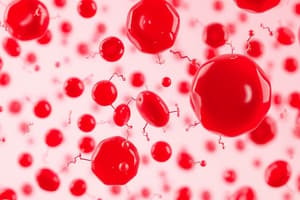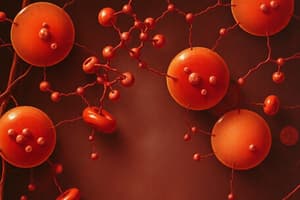Podcast
Questions and Answers
What is the importance of hepatic portal circulation?
What is the importance of hepatic portal circulation?
Hepatic portal circulation is crucial for detoxifying substances and metabolizing nutrients by transporting blood from the digestive organs to the liver.
Which blood vessel is most used by a phlebotomist to draw blood?
Which blood vessel is most used by a phlebotomist to draw blood?
The median cubital vein is most commonly used by phlebotomists to draw blood.
What divides the heart into right and left, and what are the structures called between the atria and ventricles?
What divides the heart into right and left, and what are the structures called between the atria and ventricles?
The septum divides the heart into right and left sides, with the interatrial septum between the atria and the interventricular septum between the ventricles.
Explain the function of the cardiac conduction system.
Explain the function of the cardiac conduction system.
What is the main function of coronary circulation?
What is the main function of coronary circulation?
What are the primary functions of blood in the circulatory system?
What are the primary functions of blood in the circulatory system?
Define the cardiac cycle and the phases it includes.
Define the cardiac cycle and the phases it includes.
What distinguishes serum from plasma in terms of composition?
What distinguishes serum from plasma in terms of composition?
What is the natural pacemaker of the heart?
What is the natural pacemaker of the heart?
Explain the importance of erythropoietin (EPO) in erythropoiesis.
Explain the importance of erythropoietin (EPO) in erythropoiesis.
What are intercalated discs and why are they important in cardiomyocytes?
What are intercalated discs and why are they important in cardiomyocytes?
Describe how the morphology of erythrocytes is related to their function.
Describe how the morphology of erythrocytes is related to their function.
What occurs during the vascular spasm phase of hemostasis?
What occurs during the vascular spasm phase of hemostasis?
Identify the test that measures the percentage of red blood cells in a blood sample.
Identify the test that measures the percentage of red blood cells in a blood sample.
What are the three important steps of hemostasis?
What are the three important steps of hemostasis?
Which blood type is considered the universal donor, and why?
Which blood type is considered the universal donor, and why?
What causes the two audible heart sounds during a heartbeat?
What causes the two audible heart sounds during a heartbeat?
Define stroke volume and cardiac output.
Define stroke volume and cardiac output.
Name two diseases of the cardiovascular system and briefly describe them.
Name two diseases of the cardiovascular system and briefly describe them.
What are the primary functions of the lymphatic system?
What are the primary functions of the lymphatic system?
How does plasma in capillaries become lymph?
How does plasma in capillaries become lymph?
Define innate (non-specific) immunity and provide an example.
Define innate (non-specific) immunity and provide an example.
What distinguishes humoral immunity from cellular immunity?
What distinguishes humoral immunity from cellular immunity?
What role do helper T cells play in the immune response?
What role do helper T cells play in the immune response?
What is hemolytic disease of the newborn (HDN) and how can it be treated?
What is hemolytic disease of the newborn (HDN) and how can it be treated?
Define agglutination in the context of blood.
Define agglutination in the context of blood.
What are the three types of blood vessels, and what are their primary functions?
What are the three types of blood vessels, and what are their primary functions?
Explain the difference between vasoconstriction and vasodilation.
Explain the difference between vasoconstriction and vasodilation.
What is perfusion and why is it important in capillaries?
What is perfusion and why is it important in capillaries?
Define blood pressure and identify the instrument used to measure it.
Define blood pressure and identify the instrument used to measure it.
What do the blue and red colors represent in blood vessel images?
What do the blue and red colors represent in blood vessel images?
What is the normal blood pressure measurement in adults?
What is the normal blood pressure measurement in adults?
Flashcards
What is Stroke Volume?
What is Stroke Volume?
The volume of blood pumped out of the left ventricle with each heartbeat.
What is Cardiac Output?
What is Cardiac Output?
The amount of blood pumped by the heart per minute.
What is Myocardial Infarction?
What is Myocardial Infarction?
A condition where the heart muscle is damaged due to a lack of blood flow, often caused by a blockage in a coronary artery.
What is Pericarditis?
What is Pericarditis?
Signup and view all the flashcards
What is Bradycardia?
What is Bradycardia?
Signup and view all the flashcards
What is Tachycardia?
What is Tachycardia?
Signup and view all the flashcards
What is Atherosclerosis?
What is Atherosclerosis?
Signup and view all the flashcards
What is Hypertension?
What is Hypertension?
Signup and view all the flashcards
Perfusion
Perfusion
Signup and view all the flashcards
Capillaries
Capillaries
Signup and view all the flashcards
Blood Pressure
Blood Pressure
Signup and view all the flashcards
Systolic Blood Pressure
Systolic Blood Pressure
Signup and view all the flashcards
Diastolic Blood Pressure
Diastolic Blood Pressure
Signup and view all the flashcards
Pulse
Pulse
Signup and view all the flashcards
Cardiac Output
Cardiac Output
Signup and view all the flashcards
Vasoconstriction
Vasoconstriction
Signup and view all the flashcards
Hematopoiesis
Hematopoiesis
Signup and view all the flashcards
Hemostasis
Hemostasis
Signup and view all the flashcards
Fibrinolysis
Fibrinolysis
Signup and view all the flashcards
Anemia
Anemia
Signup and view all the flashcards
Polycythemia
Polycythemia
Signup and view all the flashcards
Erythropoietin (EPO)
Erythropoietin (EPO)
Signup and view all the flashcards
Erythropoiesis
Erythropoiesis
Signup and view all the flashcards
Hemoglobin
Hemoglobin
Signup and view all the flashcards
Hepatic portal circulation
Hepatic portal circulation
Signup and view all the flashcards
Which vein do phlebotomists use for blood draws?
Which vein do phlebotomists use for blood draws?
Signup and view all the flashcards
What are the functions of the CVS?
What are the functions of the CVS?
Signup and view all the flashcards
How does the CVS work with the respiratory system?
How does the CVS work with the respiratory system?
Signup and view all the flashcards
Why is the myocardium the thickest in the left ventricle?
Why is the myocardium the thickest in the left ventricle?
Signup and view all the flashcards
List the heart layers from superficial to deep
List the heart layers from superficial to deep
Signup and view all the flashcards
Name the heart valves and their locations.
Name the heart valves and their locations.
Signup and view all the flashcards
What is the function of the cardiac conduction system?
What is the function of the cardiac conduction system?
Signup and view all the flashcards
Study Notes
Module 1 Blood Chapter 18
- Blood Functions: List the functions of blood.
- Whole Blood Components: Identify the two main components of whole blood.
- Plasma Components: List the components of plasma.
- Plasma Proteins: Name important plasma proteins and their functions.
- Serum vs. Plasma: Differentiate between serum and plasma.
- Formed Elements: Name the formed elements of the blood.
- Erythrocytes (Red Blood Cells): Describe erythrocyte morphology and how it relates to function, describe function, structure of hemoglobin its function, and their life span, including breakdown products of RBCs and hemoglobin.
- Oxygenated vs. Deoxygenated Blood: Explain the difference.
- Anemia and Polycythemia: Define anemia and polycythemia.
- Erythropoiesis: Define erythropoiesis and the importance of erythropoietin (EPO).
- RBC Percentage Test: Name the test to measure the percentage of RBCs.
- Leukocytes (White Blood Cells): Describe the function of each of the 5 types of leukocytes, classify lymphocytes and their functions and what monocytes differentiate into.
- CBC and CBC Diff: Explain what the tests stand for, identify the importance of their order by a healthcare provider..
- Platelets (Thrombocytes): Describe platelet morphology, precursor cells, functions, and the function of thrombopoietin.
- Hematopoiesis: Define hematopoiesis, location, and hematopoietic stem cells.
- Hematopoiesis End Product: Identify the cells produced at the end of hematopoiesis.
- Hemostasis: Define hemostasis and identify and describe the 3 steps (vascular spasm, platelet plug, and coagulation/clot formation).
- Hemorrhage: Define hemorrhage.
- Fibrinolysis: Define fibrinolysis.
Module 1 Blood Vessels and Circulation Chapter 20
- Blood Vessel Types: Name the 3 types of blood vessels and their functions.
- Blood Vessel Color Representation: Explain the significance of blue and red colors on vessel images.
- Blood Flow Direction: Understand the unidirectional flow in blood vessels.
- Arteries vs. Veins Comparison: Compare and contrast arteries and veins regarding direction of flow, pressure, and tunics that make up their walls.
- Microscopic Blood Vessels: Identify microscopic blood vessels.
- Vasoconstriction and Vasodilation: Define vasoconstriction and vasodilation.
- Arteriole Significance: Explain the significance of arterioles.
- Perfusion: Define perfusion and its role in capillaries.
- Blood Pressure Definition: Define blood pressure and the instrument used for measurement.
- Preferred Blood Vessel for Pressure Measurement: Identify the most commonly used blood vessel.
- Blood Pressure Terminology: Explain the terms "top number" and "bottom number".
- Normal Blood Pressure: State the normal blood pressure measurement (including units).
- Pulse Definition: Define pulse.
- Pulse Palpation Locations: Identify common areas to palpate a pulse.
Module 2 Cardiovascular System Chapter 19
- CVS Functions: List the functions of the cardiovascular system.
- CVS and Respiratory System Interaction: Explain the interaction of the CVS and respiratory system.
- Heart Anatomy: Describe the layers of the heart, atrioventricular valves, chordae tendineae, papillary muscles, semilunar valves, and the four chambers.
- Heart Function: Describe the function of the left and right sides of the heart (blood types and destinations).
- Coronary Circulation: Define coronary circulation, including the location and function of the coronary arteries and coronary sinus.
Module 3 Lymphatic System Chapter 21
- Lymphatic System Functions: List the functions of the lymphatic system.
- Lymph Flow: Describe the flow of lymph from capillaries, how it transforms into lymph, and its return to the blood.
- Lymphatic Drainage Location: State where lymph eventually drains into the circulatory system.
- Lymph Duct Anatomy: Describe the right lymphatic duct and thoracic duct, identifying the areas they drain.
- Lymphatic Organ Physiology and Anatomy: Describe the anatomy and physiology of lymphatic organs (lymphatic vessels, bone marrow, thymus, spleen, lymph nodes, and mucosa-associated lymphoid tissue (MALT)).
- Innate Immunity: Define innate immunity, list barrier defenses, and describe the role of phagocytes (e.g., lysozyme, interferons).
- Adaptive Immunity: Define adaptive immunity.
- Immune Response Types: Describe humoral and cellular immunity, antigen definition, T-cell types, and their functions.
- Antibody Function: Describe antibody function.
- Immune Response Types: Describe primary and secondary immune responses, and the importance of memory cells.
Studying That Suits You
Use AI to generate personalized quizzes and flashcards to suit your learning preferences.




